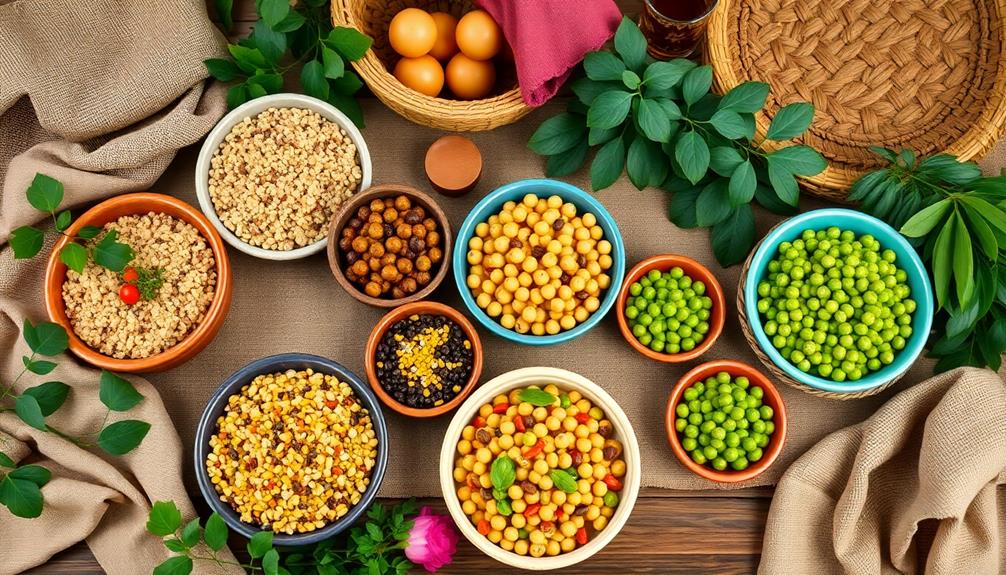Plant-based proteins can elevate your boho lifestyle with easy and nutritious options. Think legumes like lentils and chickpeas, which pack a protein punch and offer various health benefits. Nuts and seeds, such as almonds and hemp seeds, add delicious crunch and healthy fats to your meals. Whole grains like quinoa and oats provide complete proteins too. Mix and match these sources to create colorful, nutrient-rich dishes. Don't forget to support local farmers and emphasize sustainable practices in your cooking. Keep exploring these vibrant options, and you'll discover even more ways to enhance your plant-based journey.
Key Takeaways
- Plant-based protein sources include legumes, nuts, seeds, whole grains, and soy products, providing essential nutrients and health benefits.
- Lentils, chickpeas, and black beans are top legumes, offering 15-18 grams of protein per cooked cup.
- Nuts and seeds like almonds and hemp seeds provide 6-9.5 grams of protein per ounce and are rich in healthy fats.
- Whole grains such as quinoa and oats offer 5-9 grams of protein per cooked cup and are crucial for a balanced diet.
- Sustainable sourcing practices, like supporting local farmers and choosing organic ingredients, enhance nutrition and environmental impact.
Understanding Plant-Based Proteins
When you explore plant-based proteins, you'll discover a wide range of nutritious options that can easily fit into your diet. A plant-based diet is rich in protein-rich foods like legumes, nuts, seeds, whole grains, and soy products such as tofu and tempeh.
For instance, a 100-gram serving of cooked lentils offers around 9 grams of protein, making them both affordable and nutritious. Quinoa stands out as a complete protein, providing all nine essential amino acids and about 8 grams of protein per cooked cup.
Incorporating these diverse protein sources not only enhances your overall nutrient intake but also supports your health. Different plant-based proteins offer unique vitamins, minerals, and phytonutrients that contribute to your well-being.
By adding a little variety to your meals, you can enjoy a more balanced diet while reducing the risk of chronic diseases. With a focus on whole-food options, you'll find that plant-based proteins aren't just healthy but also delicious and satisfying.
Embracing these foods can transform your meals and provide the nourishment your body craves.
Top Legume Options
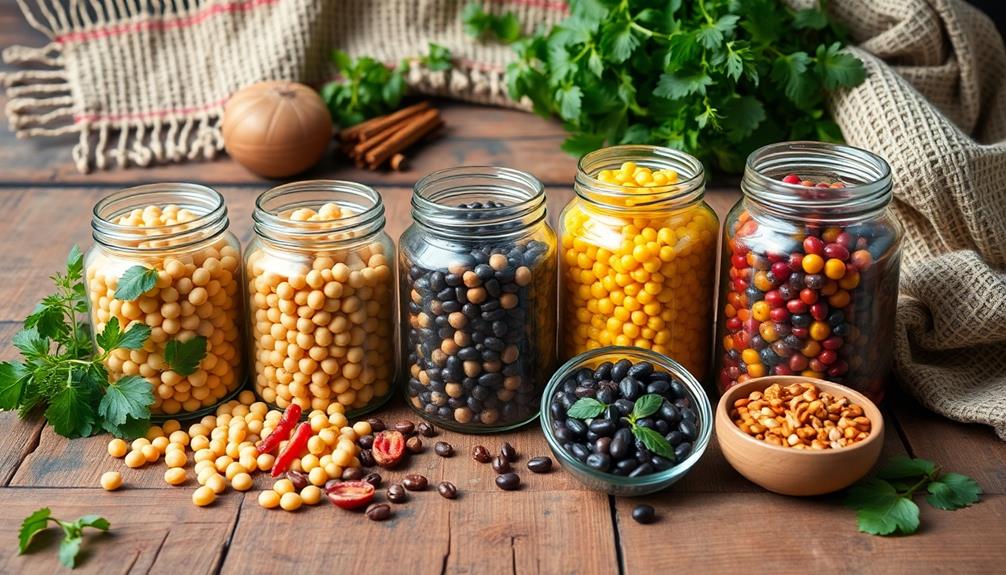
When you're looking for a nutritious boost, legumes are some of the best options available. They not only pack a punch with protein but also offer various health benefits that can enhance your meals.
Let's explore popular legume varieties, their cooking tips, and the health advantages they bring to your diet.
Health Benefits of Legumes
In recent years, legumes have gained popularity as a powerhouse of nutrition, offering a wealth of health benefits that make them a smart addition to your diet.
These little gems, like lentils, chickpeas, and black beans, pack a serious punch with around 15-20 grams of protein per cooked cup. They also bring a little bit of dietary fiber to the table—about 15.6 grams in a single cup of lentils—helping with digestion and keeping you full.
The advantages don't stop there. Incorporating legumes into your meals can lead to:
- Improved heart health by lowering cholesterol levels
- Essential vitamins and minerals like iron, folate, and magnesium
- A reduced risk of chronic diseases such as type 2 diabetes
- Antioxidant properties to combat inflammation
- A low glycemic index for stable blood sugar levels
Cooking Tips and Techniques
Cooking legumes can be incredibly rewarding, as they not only boost your protein intake but also offer versatility in your meals. Here are some top tips for cooking legumes effectively.
First, soaking dried legumes overnight can greatly reduce cooking time and enhance digestibility. It also helps remove some anti-nutrients that can interfere with nutrient absorption. If you're short on time, using a pressure cooker can cut cooking time by up to 75%, making meal prep quicker and easier.
To create a complete protein profile, combine legumes with whole grains like rice or quinoa. This combination provides all nine essential amino acids necessary for peak health. Finally, don't forget to incorporate spices and herbs while cooking! They not only enhance the flavor but also add health benefits due to their anti-inflammatory and antioxidant properties.
| Cooking Method | Benefits |
|---|---|
| Soaking | Reduces cooking time, improves digestibility |
| Pressure Cooking | Cuts cooking time by up to 75% |
| Combining with Grains | Provides complete protein profile |
Utilize these tips to enjoy delicious and nutritious legume-based meals!
Popular Legume Varieties
Legumes are among the most popular plant-based protein sources, offering a variety of options to suit any meal plan.
These nutrient-packed delights not only provide protein but also deliver essential vitamins and minerals, making them a fantastic addition to your diet.
Here are some top legume options you can easily incorporate into your meals:
- Lentils: Packed with iron and folate, they boost your energy levels and support overall health with around 18 grams of protein per cooked cup.
- Chickpeas: Versatile and delicious, they can be tossed into salads, blended into hummus, or simmered in stews, contributing about 15 grams of protein per cup.
- Black Beans: With a rich flavor, they offer 15 grams of protein and over 15 grams of fiber, aiding digestion and promoting satiety.
- Kidney Beans: These beauties provide around 13 grams of protein per cup and are loaded with antioxidants and essential minerals like potassium and magnesium.
- Peas: Don't overlook them! One cup of cooked peas offers about 8 grams of protein and a delightful sweetness to your dishes.
With these legumes, you can elevate your meals while nourishing your body.
Nut and Seed Powerhouses
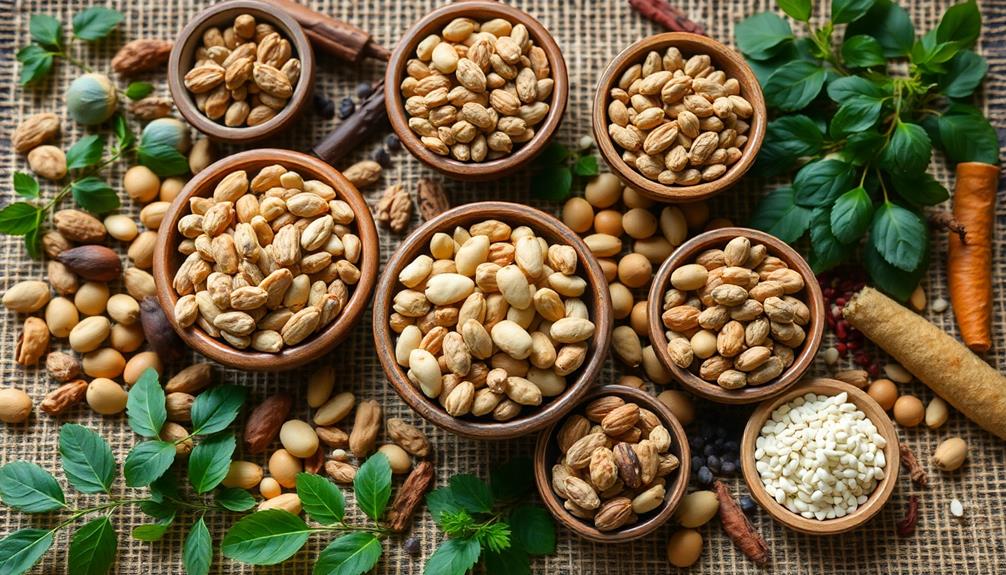
Nuts and seeds are your go-to powerhouses for plant-based protein, offering a delicious and nutritious way to fuel your body. With a variety of options available, you'll find that incorporating them into your diet can elevate your protein intake and overall health.
Here's a quick comparison of some top nut and seed sources:
| Nut/Seed | Protein (grams per ounce) |
|---|---|
| Almonds | 6 |
| Hemp Seeds | 9.5 |
| Chia Seeds | 4 |
| Walnuts | 4 |
| Pumpkin Seeds | 7 |
Each nut and seed offers unique benefits. For instance, hemp seeds not only provide high protein content but also contain essential fatty acids. Chia seeds are rich in omega-3s, promoting heart health. Walnuts boast antioxidants, while pumpkin seeds are packed with magnesium, iron, and zinc.
Whole Grains for Protein
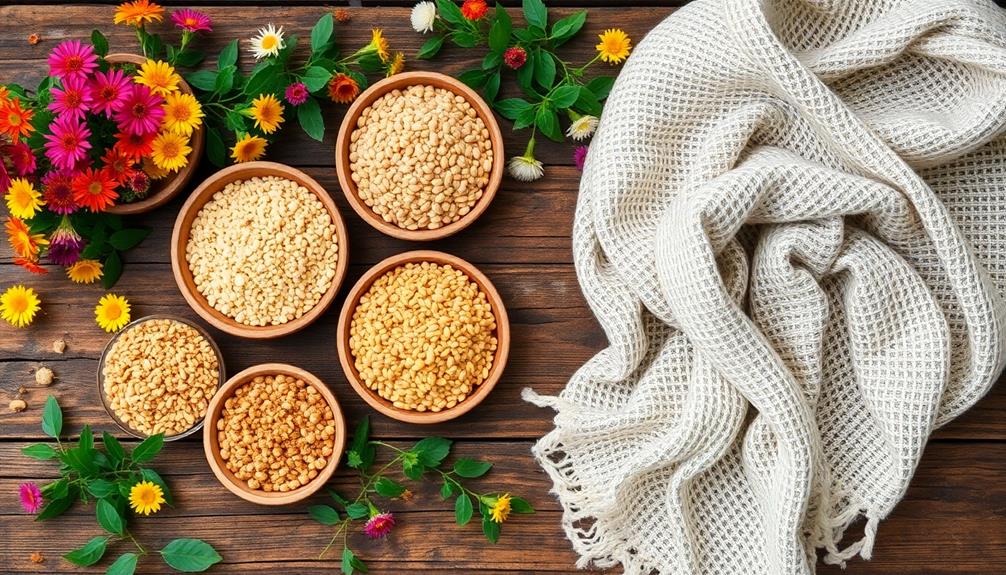
Whole grains aren't just a staple in your diet; they're also packed with protein and essential nutrients that support your health.
Options like quinoa, oats, and brown rice offer unique benefits and can easily be incorporated into your meals.
Let's explore popular whole grain choices and some tips for cooking them to maximize their nutritional value.
Nutritional Benefits of Grains
When you incorporate grains like quinoa, brown rice, and barley into your diet, you're not just adding variety; you're also boosting your protein intake.
These whole grains pack about 5-9 grams of plant-based protein per cooked cup, offering essential amino acids important for muscle repair and growth. Plus, they bring a wealth of other nutrients to your plate.
Additionally, grains like oatmeal can also provide health benefits for dogs, as they're rich in fiber and can aid in digestion, making them a great staple for pet owners to contemplate for their furry friends the benefits of oatmeal.
Reflect on the emotional benefits of embracing whole grains:
- Elevate Your Energy: Whole grains are fuel for your body, keeping your energy levels steady throughout the day.
- Feel Fulfilled: Their high fiber content promotes satiety, helping you feel satisfied and reducing cravings.
- Support Your Heart: Regular consumption may lower your risk of chronic diseases, like heart disease and diabetes.
- Aid Digestion: The fiber in whole grains supports digestive health, contributing to a happy gut.
- Savor the Variety: Enjoy diverse flavors and textures, making every meal an exciting experience.
Incorporating these grains into your meals not only enhances your nutrient intake but also supports your overall health and wellness journey.
Embrace the goodness of whole grains for a vibrant, balanced lifestyle!
Popular Whole Grain Options
In the domain of plant-based nutrition, whole grain powerhouses like quinoa, farro, and bulgur stand out as exceptional protein sources. These grains provide complete proteins, containing all nine essential amino acids your body needs to function effectively.
Additionally, incorporating essential oils for health conditions into your routine can complement a balanced diet, promoting overall wellness. If you're looking for a nutritious breakfast, don't overlook oats—they pack about 6 grams of protein per cooked cup while also delivering soluble fiber that supports heart health.
Brown rice is another excellent choice, offering around 5 grams of protein per cooked cup along with B vitamins that aid in energy metabolism.
If you're after a grain with high fiber content, barley is your go-to, providing approximately 3.5 grams of protein per cooked cup and promoting digestive health.
Consider incorporating grains like spelt and amaranth into your meals, as they can contribute around 9 to 12 grams of protein per cooked cup.
Cooking Tips and Techniques
Cooking whole grains like quinoa, farro, and bulgur can elevate your meals while boosting your protein intake. These grains provide a complete protein source, containing all nine essential amino acids necessary for ideal health.
To maximize their benefits, consider these cooking tips:
- Soak grains overnight to improve nutrient absorption and digestibility. Additionally, pairing grains with a revitalizing fruit juice combination can enhance your overall nutrient intake.
- Try sprouting grains to enhance protein content and add a crunchy texture.
- Combine grains with legumes like beans or lentils for a balanced protein profile.
- Create delicious grain bowls or salads by customizing with vibrant vegetables and plant-based proteins.
- Experiment with spices and dressings to elevate the flavor of your dishes.
With just one cup of cooked quinoa offering about 8 grams of protein, incorporating these whole grains into your meals can greatly enhance both your nutrition and satisfaction.
By using these techniques, you're not only making your meals heartier but also nourishing your body with essential vitamins and minerals.
Embrace the versatility of whole grains and enjoy the journey of creating nutritious, delicious meals that leave you feeling fulfilled and energized!
Creative Meal Ideas
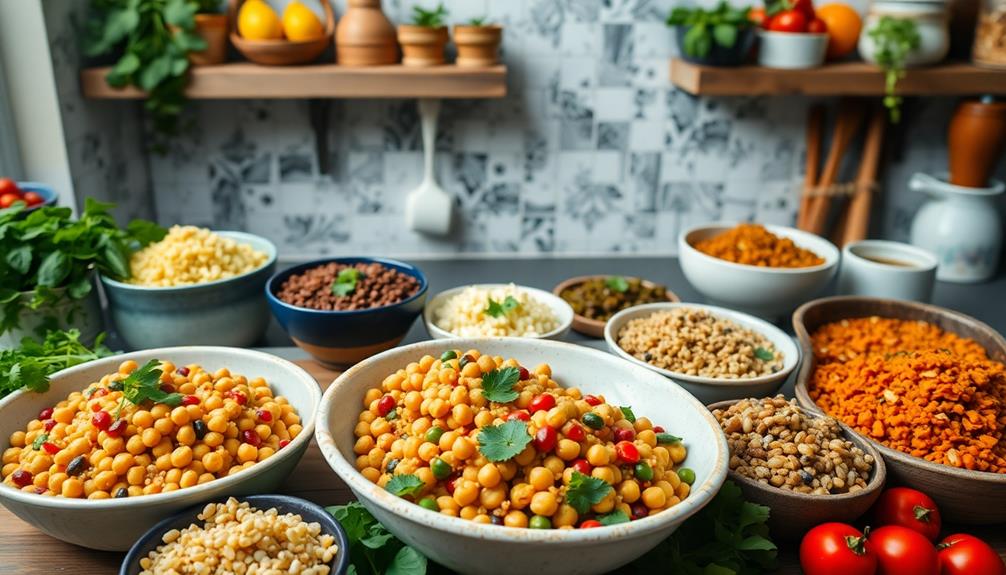
Discovering creative meal ideas with plant-based proteins can transform your culinary experience. Start by incorporating lentils into your meals—try preparing hearty lentil salads, warming soups, or even veggie burgers. They pack around 18 grams of protein per cooked cup and are rich in fiber.
Additionally, consider adding juices rich in vitamins to your diet, as they can complement your protein-rich meals and promote overall health.
Next, use quinoa as a versatile base for grain bowls or as a delicious side dish. This complete protein provides about 8 grams of protein per cooked cup and contains all nine essential amino acids.
Don't overlook chickpeas; toss them into hummus, curries, or roast them for a crunchy snack. They deliver approximately 15 grams of protein per cooked cup, along with essential vitamins and minerals.
For a protein boost, add tempeh or tofu to your stir-fries, tacos, or salads. Tempeh offers an impressive 31 grams of protein per cup, while tofu provides around 20 grams.
Sustainable Sourcing Practices
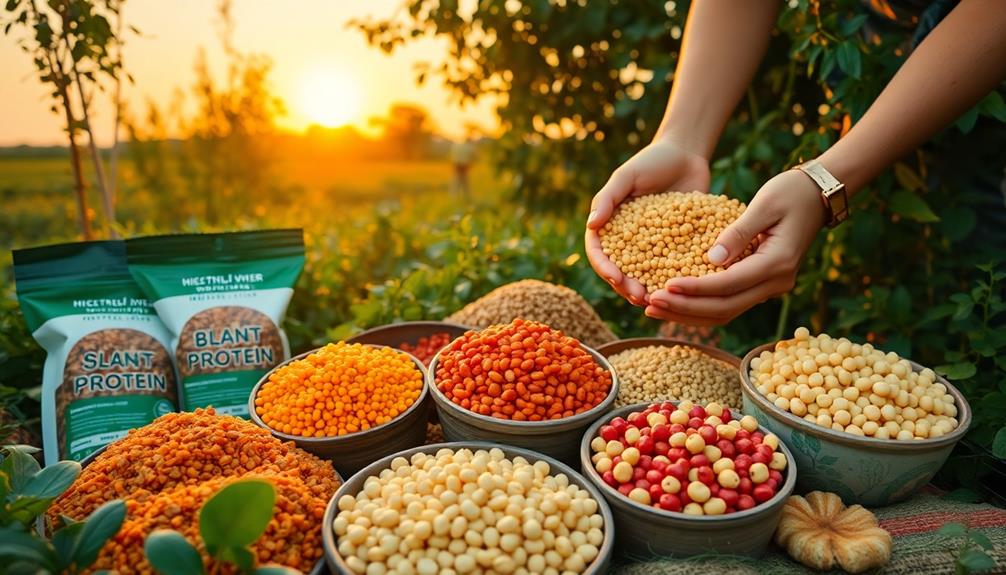
Sustainable sourcing practices for plant-based proteins play an essential role in promoting a healthier planet and your well-being. By prioritizing local and seasonal ingredients, you not only enjoy fresher flavors but also help reduce carbon footprints and support local agriculture.
When you choose organic legumes, nuts, seeds, and whole grains, you enhance your nutrient intake while promoting biodiversity and healthier ecosystems. Additionally, engaging children in hands-on learning experiences through STEM education can inspire the next generation to appreciate sustainable practices and the importance of healthy eating.
Consider incorporating these practices into your routine:
- Support local farmers by shopping at farmers' markets or joining a community-supported agriculture program.
- Choose organic ingredients that foster biodiversity and reduce harmful chemicals.
- Engage in community gardens or urban farming initiatives to access fresh produce and connect with your neighbors.
- Select sustainable brands for products like tofu and tempeh, focusing on ethical sourcing and minimal packaging.
- Adopt zero-waste cooking by using all parts of your ingredients, reducing food waste, and maximizing every resource.
Frequently Asked Questions
What Is the Best Source of Plant-Based Protein?
When considering the best source of plant-based protein, you can't go wrong with legumes like lentils and chickpeas. Tofu and tempeh also pack a protein punch, making them excellent choices for your diet.
How Do Plant-Based Eaters Get Enough Protein?
When it comes to getting enough protein, you can't judge a book by its cover. You'll find plenty of protein in legumes, nuts, seeds, and grains—just mix them up to meet your needs daily!
How to Get 100 Grams of Protein a Day on a Plant-Based Diet?
To get 100 grams of protein daily on a plant-based diet, include lentils, chickpeas, quinoa, nuts, and seeds in your meals. Don't forget tofu and plant-based protein powders for easy, nutritious boosts throughout the day.
How to Get 200 Grams of Protein on Plant-Based Diet?
To reach 200 grams of protein, mix high-protein legumes like lentils and chickpeas into meals, add quinoa and farro, use protein powders, and snack on nuts while incorporating tofu and tempeh into your dishes.
Conclusion
As you commence your journey through the vibrant world of plant-based proteins, remember that each bite is a step toward nourishing both body and planet. By embracing legumes, nuts, seeds, and whole grains, you're weaving a tapestry of flavors and nutrients that dance on your palate. So, gather these treasures and let your meals bloom with creativity and sustainability. In this garden of choices, you'll find strength in every delicious morsel, fueling your vibrant lifestyle.

